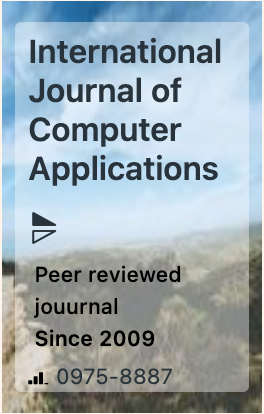The week's pick
Random Articles
Reseach Article
Generative AI-based Intrusion Detection of Imbalanced Network Traffic using Generative Adversarial Variational Auto-Encoder
| International Journal of Computer Applications |
| Foundation of Computer Science (FCS), NY, USA |
| Volume 187 - Number 15 |
| Year of Publication: 2025 |
| Authors: R. Saranya, S.L.Jayalakshmi |
 10.5120/ijca2025925152
10.5120/ijca2025925152
|
R. Saranya, S.L.Jayalakshmi . Generative AI-based Intrusion Detection of Imbalanced Network Traffic using Generative Adversarial Variational Auto-Encoder. International Journal of Computer Applications. 187, 15 ( Jun 2025), 9-18. DOI=10.5120/ijca2025925152
Abstract
Knowledge of system security becomes more and more important as ever-evolving network threats arise. Intrusion detection, a crucial component of cybersecurity, recognizes unusual activity based on traffic patterns. However, harmful cyberattacks can frequently hide enormous amounts of legitimate data in unbalanced network traffic. Generative AI models can be utilized to address this imbalance by generating synthetic data that can improve the development of machine learning models. Traditional intrusion detection systems (IDS) often struggle with imbalanced data, where benign traffic overwhelmingly outnumbers malicious traffic. This imbalance can lead to poor detection rates for rare but significant attacks. To overcome this challenge, a novel approach is proposed using a Generative Adversarial Variational Auto-Encoder (GAVAE) to improve the detection of intrusions in imbalanced network traffic. By combining the probabilistic latent space learning of Variational Auto-Encoders (VAEs) with the adversarial training framework of Generative Adversarial Networks (GANs), the proposed method generates high-quality synthetic samples of minority classes. These synthetic samples augment the training dataset, leading to a more balanced distribution and increased throughput of the intrusion detection model. The proposed model was evaluated on the UNSW-NB15 and NSL-KDD data sets. The experimental results demonstrate that the proposed GAVAE model significantly improves the detection capabilities compared to traditional methods, offering a robust solution for network security.
References
- Ankalaki, S., Rajesh, A. A., Pallavi, M., Hukkeri, G. S., Jan, T., Naik, G. R. (2025). Cyber Attack Prediction: From Traditional Machine Learning to Generative Artificial Intelligence. IEEE Access.
- Liu, Chang, Ruslan Antypenko, Iryna Sushko, and Oksana Zakharchenko. ”Intrusion detection system after data augmentation schemes based on the VAE and CVAE.” IEEE Transactions on Reliability 71, no. 2 (2022): 1000-1010.
- Zavrak, Sultan, and Murat Iskefiyeli. ”Anomaly-based intrusion detection from network flow features using variational autoencoder.” IEEE Access 8 (2020): 108346- 108358.
- Liu, Lan, Pengcheng Wang, Jun Lin, and Langzhou Liu. ”Intrusion detection of imbalanced network traffic based on machine learning and deep learning.” IEEE access 9 (2020): 7550-7563.
- Zhang, Xiaoxuan, Jing Ran, and Jize Mi. ”An intrusion detection system based on convolutional neural network for imbalanced network traffic.” In 2019 IEEE 7th international conference on computer science and network technology (ICCSNT), pp. 456-460. IEEE, 2019.
- Liu, Hongyu, and Bo Lang. ”Machine learning and deep learning methods for intrusion detection systems: A survey.” applied sciences 9, no. 20 (2019): 4396.
- Goodfellow, I. J., Pouget-Abadie, J., Mirza, M., Xu, B., Warde-Farley, D., Ozair, S., ... Bengio, Y. (2014). Generative adversarial networks. arXiv 2014. arXiv preprint arXiv:1406.2661, 10
- Bamhdi, Alwi M., Iram Abrar, and Faheem Masoodi. ”An ensemble based approach for effective intrusion detection using majority voting.” Telkomnika (Telecommunication Computing Electronics and Control) 19, no. 2 (2021): 664-671.
- Bhati, Nitesh Singh, and Manju Khari. ”A new ensemble based approach for intrusion detection system using voting.” Journal of Intelligent Fuzzy Systems 42, no. 2 (2022): 969- 979.
- Abbas, Adeel, Muazzam A. Khan, Shahid Latif, Maria Ajaz, Awais Aziz Shah, and Jawad Ahmad. ”A new ensemble-based intrusion detection system for internet of things.” Arabian Journal for Science and Engineering (2022): 1-15.
- Shu, Dule, Nandi O. Leslie, Charles A. Kamhoua, and Conrad S. Tucker. ”Generative adversarial attacks against intrusion detection systems using active learning.” In Proceedings of the 2nd ACM workshop on wireless security and machine learning, pp. 1-6. 2020.
- Gan, Baiqiang, Yuqiang Chen, Qiuping Dong, Jianlan Guo, and Rongxia Wang. ”A convolutional neural network intrusion detection method based on data imbalance.” The Journal of Supercomputing 78, no. 18 (2022): 19401-19434.
- Arafah, Mohammad. ”Improving intrusion detection system performance using generative adversarial networks architecture.” PhD diss., Loughborough University, 2023.
- Vu, Ly, Quang Uy Nguyen, Diep N. Nguyen, Dinh Thai Hoang, and Eryk Dutkiewicz. ”Deep generative learning models for cloud intrusion detection systems.” IEEE Transactions on Cybernetics 53, no. 1 (2022): 565-577.
- Ibrahim, Bekkouch Imad, Dragos¸ Constantin Nicolae, Adil Khan, Syed Imran Ali, and Asad Khattak. ”VAE-GAN based zero-shot outlier detection.” In Proceedings of the 2020 4th international symposium on computer science and intelligent control, pp. 1-5. 2020.
- Zhang, Ying, and Qiang Liu. ”On IoT intrusion detection based on data augmentation for enhancing learning on unbalanced samples.” Future Generation Computer Systems 133 (2022): 213-227.
- Zhang, Junjie, and Ying Zhao. ”Research on intrusion detection method based on generative adversarial network.” In 2021 International Conference on Big Data Analysis and Computer Science (BDACS), pp. 264-268. IEEE, 2021.
- Navya, V. K., J. Adithi, Diksha Rudrawal, Harshita Tailor, and Nileena James. ”Intrusion detection system using deep neural networks (DNN).” In 2021 International Conference on Advancements in Electrical, Electronics, Communication, Computing and Automation (ICAECA), pp. 1-6. IEEE, 2021.
- Samriya, Jitendra Kumar, Rajeev Tiwari, Xiaochun Cheng, Rahul Kumar Singh, Achyut Shankar, and Manoj Kumar. ”Network intrusion detection using ACO-DNN model with DVFS based energy optimization in cloud framework.” Sustainable Computing: Informatics and Systems 35 (2022): 100746.
- Zhao, C., Du, H., Niyato, D., Kang, J., Xiong, Z., Kim, D. I., ... Letaief, K. B. (2024). Generative AI for secure physical layer communications: A survey. IEEE Transactions on Cognitive Communications and Networking.
- Liu, Zhiqiang, Mohi-Ud-Din Ghulam, Ye Zhu, Xuanlin Yan, Lifang Wang, Zejun Jiang, and Jianchao Luo. ”Deep learning approach for IDS: using DNN for network anomaly detection.” In Fourth International Congress on Information and Communication Technology: ICICT 2019, London, Volume 1, pp. 471-479. Springer Singapore, 2020.
- Vu, T. H., Jagatheesaperumal, S. K., Nguyen, M. D., Van Huynh, N., Kim, S., Pham, Q. V. (2024). Applications of Generative AI (GAI) for Mobile and Wireless Networking: A Survey. arXiv preprint arXiv:2405.20024.
- Moraboena, Srikanthyadav, Gayatri Ketepalli, and Padmaja Ragam. ”A Deep Learning Approach to Network Intrusion Detection Using Deep Autoencoder.” Revue d’Intelligence Artificielle 34, no. 4 (2020).
- Andresini, Giuseppina, Annalisa Appice, and Donato Malerba. ”Autoencoder- based deep metric learning for network intrusion detection.” Information Sciences 569 (2021): 706-727.
- Sadaf, Kishwar, and Jabeen Sultana. ”Intrusion detection based on autoencoder and isolation forest in fog computing.” IEEE Access 8 (2020): 167059-167068.
- Yang, Y., Zheng, K., Wu, B., Yang, Y., Wang, X. (2020). Network intrusion detection based on supervised adversarial variational auto-encoder with regularization. IEEE access, 8, 42169-42184.
Index Terms
Keywords

